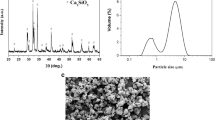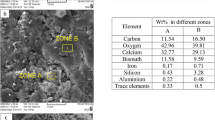Abstract
The bioactivity of calcium silicate mineral trioxide aggregate (MTA) cements has been attributed to their ability to produce apatite in presence of phosphate-containing fluids. This study evaluated surface morphology and chemical transformations of an experimental accelerated calcium-silicate cement as a function of soaking time in different phosphate-containing solutions. Cement discs were immersed in Dulbecco’s phosphate-buffered saline (DPBS) or Hank’s balanced salt solution (HBSS) for different times (1–180 days) and analysed by scanning electron microscopy connected with an energy dispersive X-ray analysis (SEM-EDX) and micro-Raman spectroscopy. SEM-EDX revealed Ca and P peaks after 14 days in DPBS. A thin Ca- and P-rich crystalline coating layer was detected after 60 days. A thicker multilayered coating was observed after 180 days. Micro-Raman disclosed the 965-cm−1 phosphate band at 7 days only on samples stored in DPBS and later the 590- and 435-cm−1 phosphate bands. After 60–180 days, a layer ∼200–900 μm thick formed displaying the bands of carbonated apatite (at 1,077, 965, 590, 435 cm-1) and calcite (at 1,088, 713, 280 cm−1). On HBSS-soaked, only calcite bands were observed until 90 days, and just after 180 days, a thin apatite–calcite layer appeared. Micro-Raman and SEM-EDX demonstrated the mineralization induction capacity of calcium-silicate cements (MTAs and Portland cements) with the formation of apatite after 7 days in DPBS. Longer time is necessary to observe bioactivity when cements are immersed in HBSS.






Similar content being viewed by others
References
Camilleri J, Montesin FE, Brady K, Sweeney R, Curtis R, Pitt Ford TR (2005) The constitution of mineral trioxide aggregate. Dent Mater 21:297–303
Saunders WP (2008) A prospective clinical study of periradicular surgery using mineral trioxide aggregate as a root-end filling. J Endod 34:660–665
Pace R, Giuliani V, Pagavino G (2008) Mineral trioxide aggregate as repair material for furcal perforation: case series. J Endod 34:1130–1133
Holden DT, Schwartz SA, Kirkpatrick TC, Schindler WG (2008) Clinical outcomes of artificial root-end barriers with mineral trioxide aggregate in teeth with immature apices. J Endod 34:812–817
Gandolfi MG, Farascioni S, Pashley DH, Gasparotto G, Prati C (2008) Calcium silicate coating derived from Portland cement as treatment for hypersensitive dentine. J Dent 36:565–578
Nair PNR, Duncan HF, Pitt-Ford TR, Luder HU (2009) Histological, ultrastructural and quantitative investigations on the response of healthy human pulps to experimental capping with mineral trioxide aggregate: a randomized controlled trial. Int Endod J 42:422–444
Torabinejad M, White DJ (1995) US Patent Number, 5,769,638
Camilleri J (2007) Hydration mechanisms of mineral trioxide aggregate. Int Endod J 40:462–470
Sarkar NK, Caicedo R, Ritwik P, Moiseyeva R, Kawashima I (2005) Physicochemical basis of the biologic properties of mineral trioxide aggregate. J Endod 31:97–100
Bozeman TB, Lemon RR, Eleazer PD (2006) Elemental analysis of crystal precipitates from gray and white MTA. J Endod 32:425–428
Coleman NJ, Nicholson JW, Awosanya K (2007) A preliminary investigation of the in vitro bioactivity of white Portland cement. Cem Concr Res 37:1518–1523
Tay FR, Pashley DH, Rueggeberg FA, Loushine RJ, Weller RN (2007) Calcium-phosphate phase transformation produced by the interaction of the Portland cement component of white mineral trioxide aggregate with a phosphate-containing fluid. J Endod 33:1347–1351
Tay FR, Pashley DH (2008) Guided tissue remineralisation of partially demineralised human dentine. Biomaterials 29:1127–1137
Ding SJ, Kao CT, Shie MY, CJr H, Huang TH (2008) The physical and cytological properties of white MTA mixed with Na2HPO4 as an accelerant. J Endod 34:748–751
Chng HK, Islam I, Yap AUJ, Tong YW, Koh ET (2005) Properties of a new root-end filling material. J Endod 31:665–668
Islam I, Chng HK, Adrian U, Yap UJ (2006) Comparison of the physical and mechanical properties of MTA and Portland cement. J Endod 32:193–197
Wiltblank KB, Schwartz SA, Schindler WG (2007) Effect of selected accelerants on the physical properties of Mineral Trioxide Aggregate and Portland cement. J Endod 33:1235–1238
Abdullah D, Ford TR, Papaioannou S, Nicholson J, McDonald F (2002) An evaluation of accelerated Portland cement as a restorative material. Biomaterials 23:4001–4010
Kogan P, He J, Glickman GN, Watanabe I (2006) The effects of various additives on setting properties of WMTA. J Endod 32:569–572
Nelson DGA, Featherstone JDB (1982) Preparation, analysis and characterization of carbonated apatites. Calcif Tissue Int 34:S69–S75
Black L, Breen C, Yarwood J, Deng CS, Phipps J, Maitland G (2006) Hydration of tricalcium aluminate (C3A) in the presence and absence of gypsum – studied by Raman spectroscopy and X-ray diffraction. J Mater Chem 16:1263–1272
Sarma LP, Prasad PSR, Ravikumar N (1998) Raman spectroscopic study of phase transitions in natural gypsum. J Raman Spectrosc 29:851–856
Tarrida M, Madon M, Le Rolland B, Colombet P (1995) An in-situ Raman spectroscopy study of the hydration of tricalcium silicate. Adv Cem Based Mater 2:15–20
Gastaldi D, Boccaleri E, Canonico F, Bianchi M (2007) The use of Raman spectroscopy as a versatile characterization tool for calcium sulphoaluminate cements: a compositional and hydration study. J Mater Sci 42:8426–8432
Martinez-Ramirez S, Frıas M, Domingo C (2006) Micro-Raman spectroscopy in white Portland cement hydration: long-term study at room temperature. J Raman Spectrosc 37:555–561
Gallego D, Higuita N, Garcia F, Ferrel N, Hansford DJ (2008) Bioactive coatings on Portland cement substrates: Surface precipitation of apatite-like crystals. Mater Sci Engin 28:347–352
Potgieter-Vermaak SS, Potgieter JH, Van Grieken R (2006) The application of Raman spectrometry to investigate and characterize cement, part I: a review. Cem Concr Res 36:656–662
Taddei P, Tinti A, Gandolfi MG, Rossi PL, Prati C (2009) Vibrational study on the bioactivity of portland cement-based materials for endodontic use. J Mol Structure 924–926:548–554
Takita T, Hayashi M, Takeiti O, Ogiso B, Suzuki N, Otsuka K, Ito K (2006) Effect of mineral trioxide aggregate on proliferation of cultured human dental pulp cells. Int Endod J 39:415–422
Tuna D, Ölmez A (2008) Clinical long-term evaluation of MTA as a direct pulp capping material in primary teeth. Int Endod J 41:273–278
Siqueira JF, Guimarães-Pinto T, Rõcas IN (2007) Effect of chemomechanical preparation with 2.5% sodium hypochlorite and intracanal medication with calcium hydroxide on cultivable bacteria in infected root canals. J Endod 33:800–805
Coleman NJ, Awosanya K, Nicholson JW (2009) Aspects of the in vitro bioactivity of hydraulic calcium (alumino)silicate cement. J Biomed Mater Res Part 90A:166–174
Zhao W, Wang J, Zhai W, Wang Z, Chang J (2005) The self-setting properties and in vitro bioactivity of tricalcium silicate. Biomaterials 26:6113–6121
Fujita Y, Yamamuro T, Nakamura T, Kotani S, Ohtsuki C, Kokubo T (1991) The bonding behavior of calcite to bone. J Biomed Mater Res 25:991–1003
Kamali S, Moranville M, Leclercq S (2008) Material and environmental parameter effects on the leaching of cement pastes: experiments and modelling. Cem Concr Res 38:575–585
Gandolfi MG, Sauro S, Mannocci F, Zanna S, Capoferri M, Prati C, Mongiorgi R (2007) New tetrasilicate cement as retrograde filling material: an in vitro study on fluid penetration. J Endod 33:1082–1085
Shie MY, Chen DCH, Wang CY, Chiang TY, Ding SJ (2008) Immersion behaviour of gelatine-containing calcium phosphate cement. Acta Biomater 4:646–655
Kokubo T, Takadama H (2006) How useful is SBF in predicting in vivo bone bioactivity? Biomaterials 27:2907–2915
Gandolfi MG, Perut F, Ciapetti G, Mongiorgi R, Prati C (2008) New Portland cement-based materials for endodontics mixed with articaine solution: a study of cellular response. J Endod 34:39–44
Gandolfi MG, Pagani S, Perut F, Ciapetti G, Baldini N, Mongiorgi R, Prati C (2008) Innovative silicate-based cements for endodontics: a study of osteoblast-like cell response. J Biomed Mater Res 86(A):477–486
Gandolfi MG, Ciapetti G, Perut F, Taddei P, Modena E, Rossi PL, Prati C (2009) Biomimetic calcium-silicate cements aged in simulated body solutions. Osteoblasts response and analyses of apatite coating. J Appl Biomater Biomech, in press
Camilleri J, Montesin FE, Di Silvio L, Pitt Ford TR (2005) The chemical constitution and biocompatibility of accelerated Portland cement for endodontic use. Int Endod J 38:834–842
Ribeiro DA, Duarte MA, Matsumoto MA, Marques ME, Salvadori DM (2005) Biocompatibility in vitro tests of mineral trioxide aggregate and regular and white Portland cements. J Endod 31:605–607
Koh ET, Torabinejad M, Pitt Ford TR, Brady K, McDonald F (1997) Mineral trioxide aggregate stimulates a biological response in human osteoblasts. J Biomed Mater Res 37:432–439
Al-Rabeah E, Perinpanayagam H, MacFarland D (2006) Human alveolar bone cells interact with ProRoot and tooth-colored MTA. J Endod 32:872–875
Chen CL, Huang TH, Ding SJ et al (2009) Comparison of calcium silicate cement and mineral trioxide aggregate biologic effects and bone markers expression in MG63 cells. J Endod 35:682–685
Saidon J, He J, Zhu Q, Safavi K, Spångberg LS (2003) Cell and tissue reactions to mineral trioxide aggregate and Portland cement. Oral Surg Oral Med Oral Pathol Oral Radiol Endod 95:483–489
Torabinejad M, Pitt Ford TR, McKendry DJ, Kariyawasan SP et al (2009) Histologic assessment of mineral trioxide aggregate as root-end filling in monkeys. Int Endod J 42:408–411
Masuda-Murakami Y, Kobayashi M, Wang X, Yamada Y, Kimura Y, Hossain M, Matsumoto K (2009) Effects of mineral trioxide aggregate on the differentiation of rat dental pulp cells. Acta Hystochem, doi:10.1016/j.acthis.2009.05.001
Min KS, Park HJ, Lee SK, Park SH, Hong CU, Kim HW, Lee HH, Kim EC (2008) Effect of mineral trioxide aggregate on dentin bridge formation and expression of dentin sialoprotein and heme oxygenase-1 in human dental pulp. J Endod 34:666–670
Conflict of Interest
The authors declare that they have no conflict of interest.
Author information
Authors and Affiliations
Corresponding author
Rights and permissions
About this article
Cite this article
Gandolfi, M.G., Taddei, P., Tinti, A. et al. Kinetics of apatite formation on a calcium-silicate cement for root-end filling during ageing in physiological-like phosphate solutions. Clin Oral Invest 14, 659–668 (2010). https://doi.org/10.1007/s00784-009-0356-3
Received:
Accepted:
Published:
Issue Date:
DOI: https://doi.org/10.1007/s00784-009-0356-3




